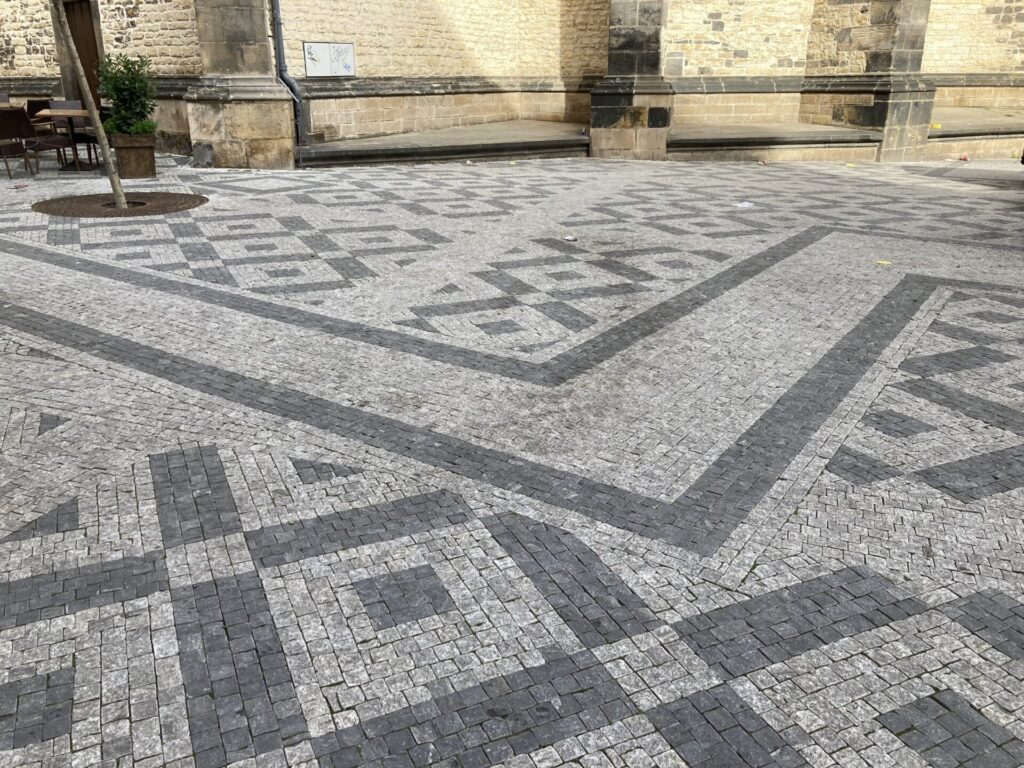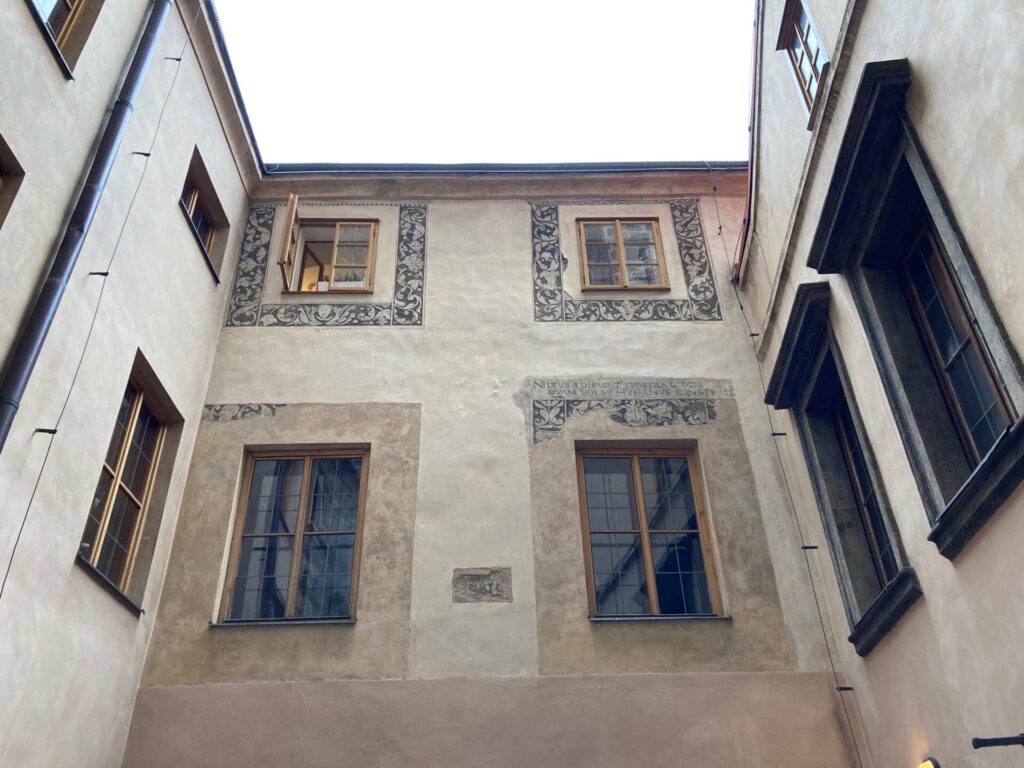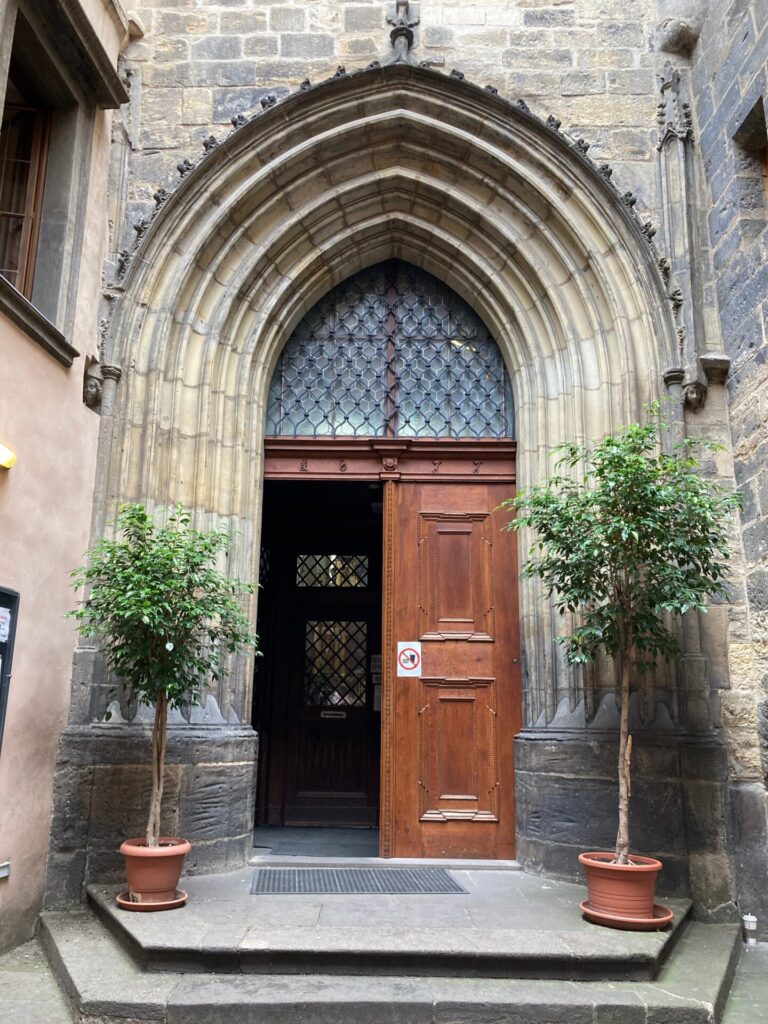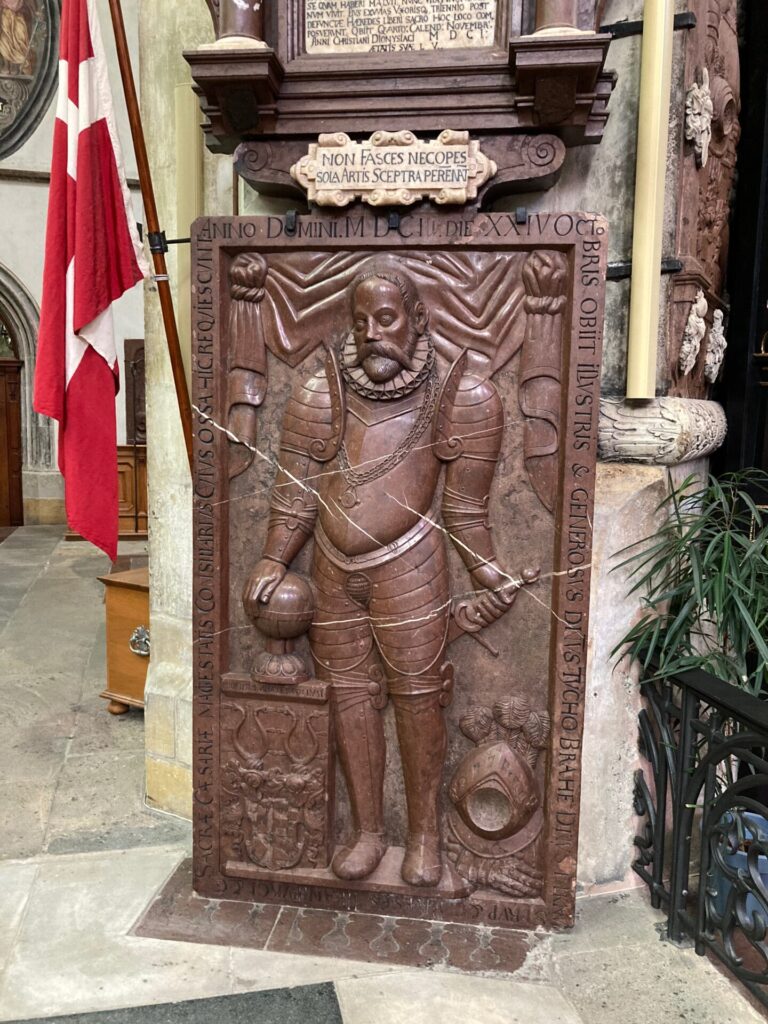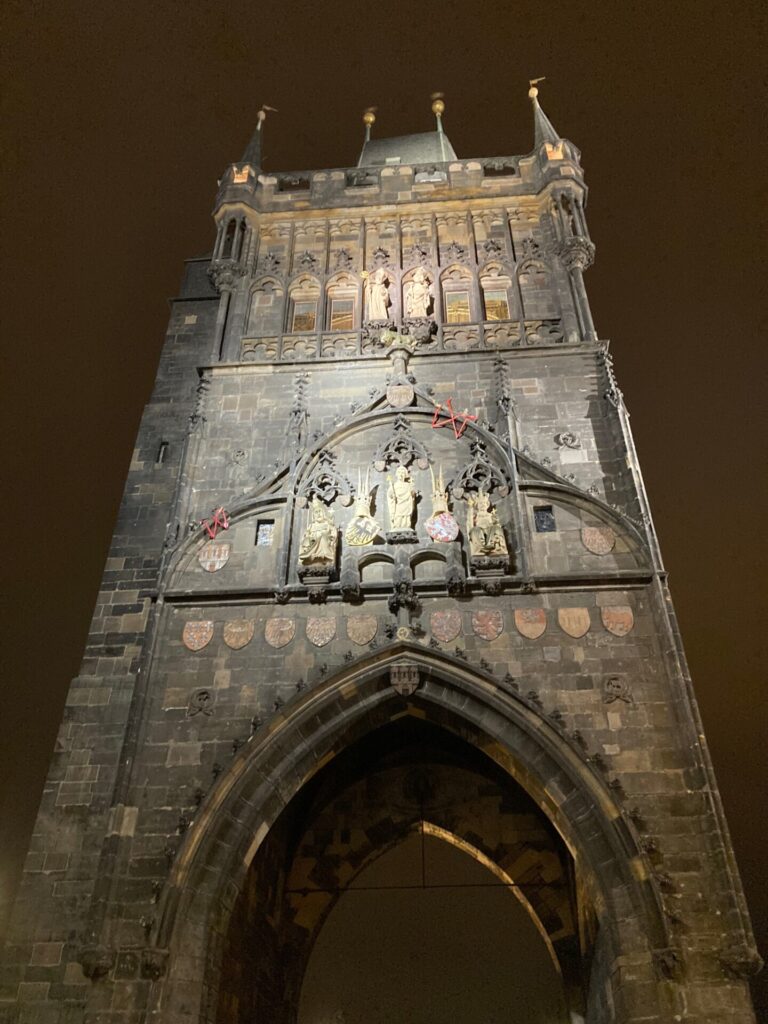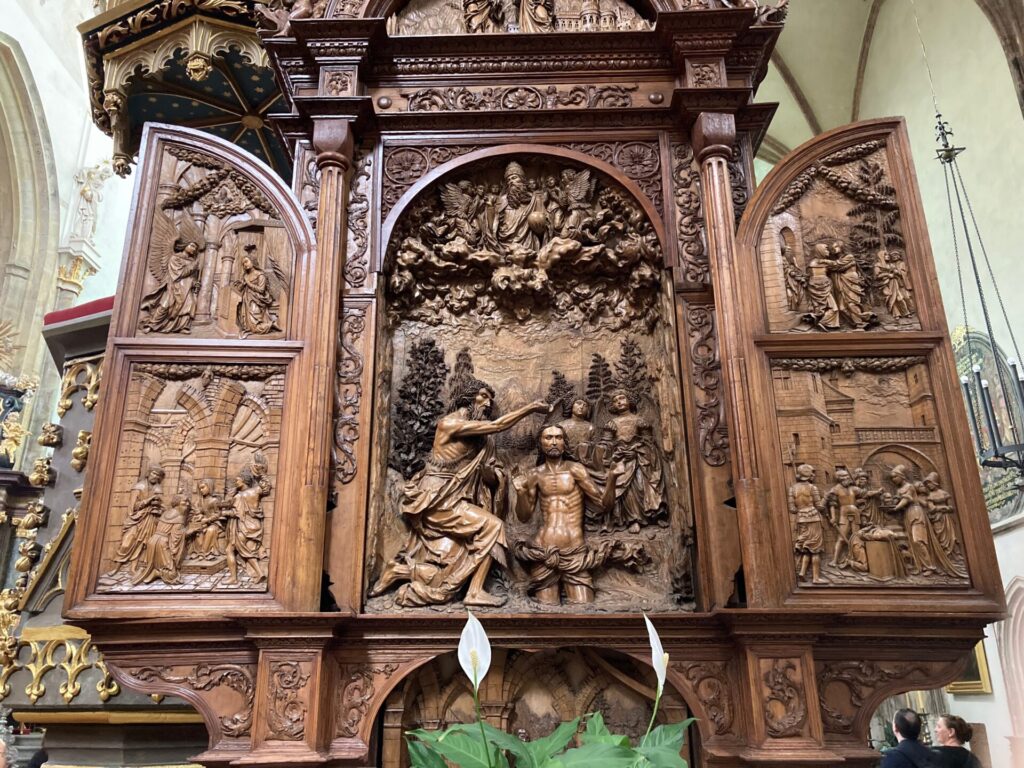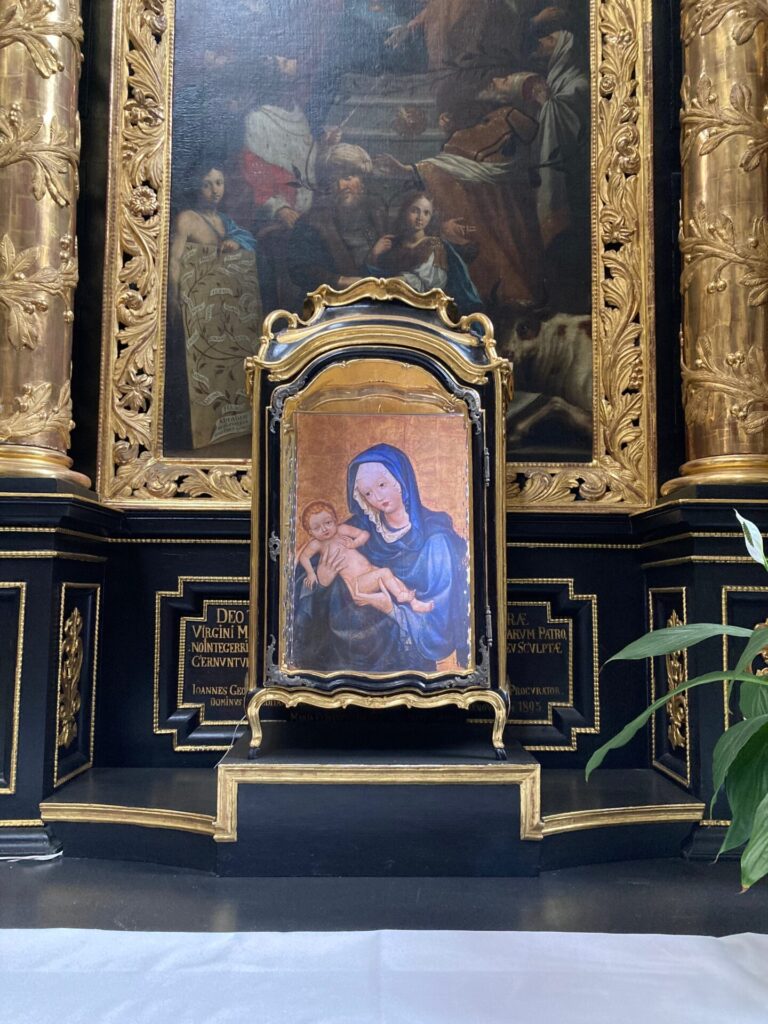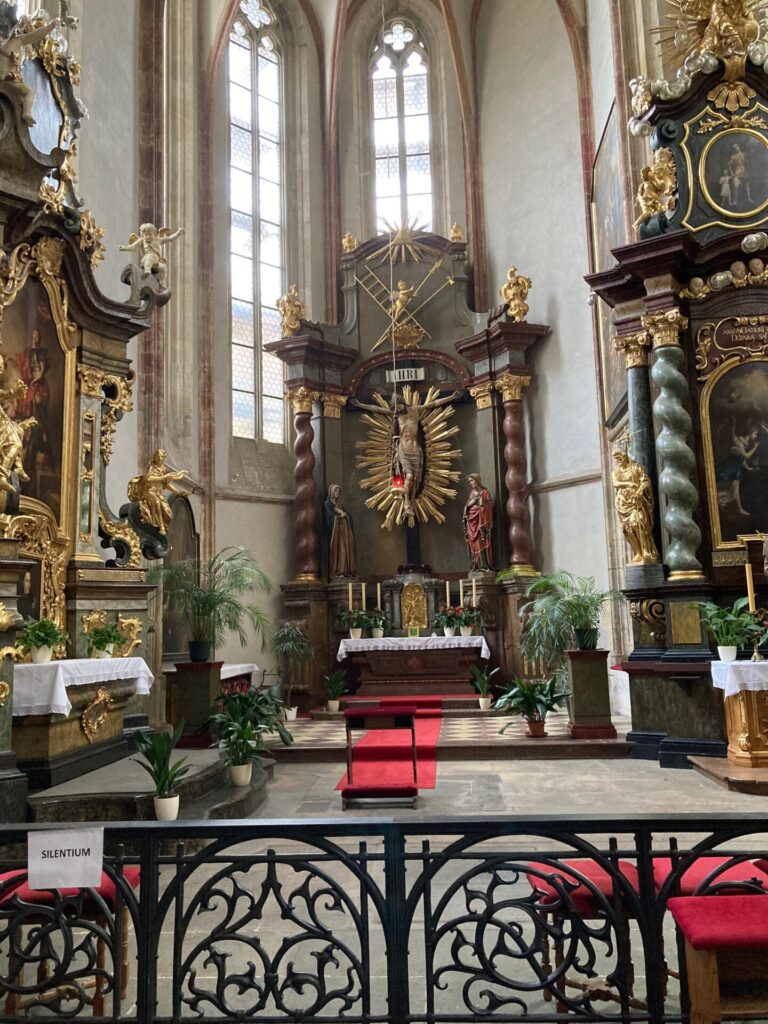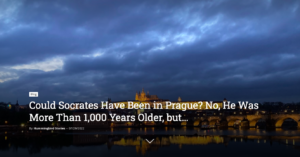The Church of Our Lady before Týn, on Old Town Square, the counterbalance of the dominating Town Hall with the astronomical clock, is the only church in Prague you cannot enter directly from the street. You must still first pass through the passageway of one of the houses in front of the church. Why is this so?
This peculiarity is clearly visible from a bird’s-eye view. The solid yellow circle indicates the church and a yellow circle identifies the house in front of it. The House at the Stone Bell is marked in green, Ungelt in blue, and the Basilica of St. James the Greater in purple.
It’s simple – and of course, it’s about money. But let’s start from the beginning. Or at least from what we know about the beginning.
The first written mention of a church on this site dates back to 1135 and is related to the merchant court, Ungelt. Ungelt was, and still is, an enclosed space, which used to have a hospital with a chapel of the Virgin Mary. The chapel was partly made of wood, and unfortunately its foundation no longer exists. Therefore, we are still determining exactly where it used to stand.
The church has this neighborhood of Ungelt in its name – the Church of Our Lady before Týn. The Ungelt Merchant’s Court has two names, both related to its function in the Middle Ages when Ungelt was the center of international trade and merchants here were under the protection of the king (which is why they all had to surrender their weapons when entering the court). They paid a fee for this, called in old German “ungelt”. But the Ungelt was also named the Týn, because the word “týn” means an enclosure or a fenced-in place.
The second church on this site was already made of stone; it was a late Romanesque to early Gothic basilica. It was located at the back of the side nave of today’s church and was pushed out to Štupartská Street. Its foundations are not only visible in the paving of the church, but also on the street.
At the end of the 13th and beginning of the 14th century, Prague experienced a considerable boom. The city grew rich and so did its burghers. That is why the burghers decided to build a church that would be the main church of the Old Town of Prague and thus come into some opposition with the St. Vitus Cathedral. The burghers would thus express their power and wealth towards the king.
The Old Town of Prague is, of course, the holder of many firsts. It has the oldest city rights, including the right to organize markets, brew beer, capital punishment, and the right to surround the city with walls, also known as the request of a mile. That is to say, no foreign craftsmen who would essentially take work from domestic artisans could settle within a radius of one mile from the city. And since the Old Town Hall is also the oldest in Bohemia (it was founded in 1338), the burghers wanted to build the second most important church in Bohemia. They succeeded, but it definitely took a lot of work.
Just like today, money played an essential role in those medieval times. The center of trade at that time was the Old Town Square where the most important markets were held. All the houses around the square are older than the church – and since they were houses at the best address, bordering Prague’s largest market square, such ownership meant financial security for the rest of your life. Therefore, building a church in the middle of the court was impossible because the markets would have to move, and the houses around the square would lose value.
Finally, a solution was found – in the backyards of the houses, which today form the front of the church, you could find what used to be in backyards of that time, such as manure pits, barns, chicken coops, and pig sties. The land for construction would be suitable, but access to it would be difficult (it would be accessible from the other side, from Ungelt, but the church would not be properly oriented. It would not follow the principle that the church entrance faces west and the altar faces east). Therefore, our ancestors had no choice but to go to church through the passage of the house standing in front of it.
The owners of the plots sold them advantageously for the church’s building. But then, together with other burghers, they participated financially in its construction. It started in 1360 and had no problem with financing. The church was built from the contributions of the townspeople but also from the tax revenues of the town hall, where the same townspeople were representatives. Simply said – the church was financed from the money of those who wanted it in the Old Town, which was everyone since everyone went to church on Sundays.

The stone part of the pulpit is originally Gothic; the canopy and staircase are from the 19th century. One of the most well-known preachers in Czech history, Jan Hus, preached here, probably the most famous of the preachers was John of Nepomuk (Jan Nepomucký).
The grave of the Danish astronomer Tycho Brahe, buried here in 1601, followed two years later by his wife. The cause of Tycho Brahe’s death was unclear. It was speculated that his bladder ruptured while observing the Sun or for social reasons when the astronomer could not get up from the feast sooner than the emperor.
His remains have already been exhumed twice – in 1901 and 2010, to determine the direct cause of death. The result determined the 95% likelihood that the astronomer’s organs were affected by carcinogenic substances, mainly mercury and arsenic, with which he worked in alchemical laboratories without any protection.
Karel Davídek, the churchwarden, was in the church for over fifty years and took care of the tomb with great care. In April 1973, he was therefore awarded the personal order of Her Majesty Queen Margrethe II of Denmark.
The year 1648 saw the last clash of the Thirty Years’ War, which had begun in 1618 with the Bohemian uprising against the Habsburgs and eventually turned into a large-scale European war between Catholics and Protestants.
At the end of July 1648, Swedish troops tried to conquer Prague. They managed to occupy and plunder Hradčany and the Lesser Town. Still, the right-bank part of the city was defended by its inhabitants, even though the Swedes continued to besiege Prague until the beginning of November. The main battles occurred on the Charles Bridge, over which the Swedish troops did not cross. If you look at the Old Town Bridge Tower from the Old Town today, you can see that it is very ornate. However, the tower is bare on the side visible from the river because the angry Swedes shot up the statues on this side of the tower.
A commemorative plaque with the coat of arms of the Old Town, where a hand with a sword commemorates the victory of the defenders of Prague over the Swedish army, is also a reminder of this.
The celebrations of this victory are also commemorated in the Church of Our Lady before Týn. In commemoration of the win, the main altar with the image of Karel Škréta’s Assumption of the Virgin Mary was built here, and the Marian Column was erected in the Old Town Square as an expression of gratitude to the Virgin Mary for saving the city from destruction.
The Marian Column was in the Old Town Square until 1918, when it was pulled down less than a week after establishing the Czechoslovak Republic as an expression of resistance against the Habsburgs. The truth is, however, that this event was organized by the recessionist and bohemian from
Žižkov, František Sauer, a close friend of the writer Jaroslav Hašek and the publisher of his first book, The Fateful Adventures of the Good Soldier Svejk During the World War.
The new Marian Column was built a century later, in the spring of 2020, during the Covid pandemic. The city was almost devoid of life – no tourists, with closed restaurants, cinemas, and theaters. Only in Old Town Square could the tapping of the stonemasons’ hammers be heard. During the second wave of Covid, in the fall of 2020, the Marian column was the only place where 100 people could gather for a service (gathering in rooms was limited to about ten people). And so the Marian Column gave new hope to the people present, even though they had to stand two meters apart with respirators on.
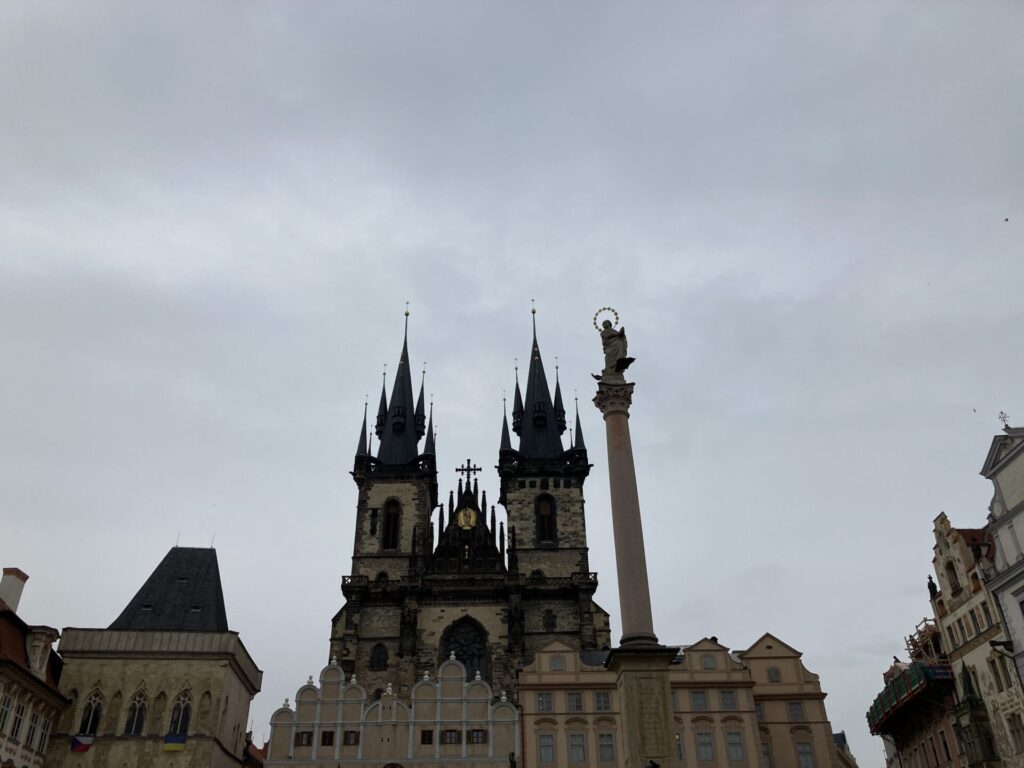
Some of “the best” of this church
A tin baptismal font in the shape of a bell – Prague’s oldest tin baptismal font. Its body was made around 1414, and the Neo-Gothic lid in 1846.
The oldest preserved altar in the church, originally from 1524-1525. It is carved from pear wood.
The oldest Baroque organ in Prague (built 1670-1673). Along with the organs in the churches in Vienna and Klostenburg, it is the only Baroque organ that has survived to this day in its original condition. The organ builder was Hans Heinrich Mundt, who also built the organs of St. Thomas Church in the Lesser Town and St. Nicholas Church in Old Town Square.
Thank you for the church tour and information to Mr. Štěpán Filipec.




















